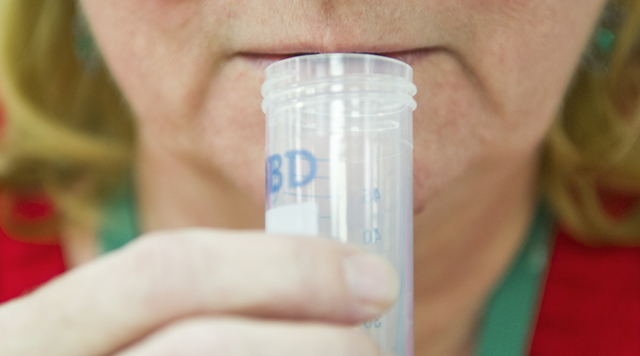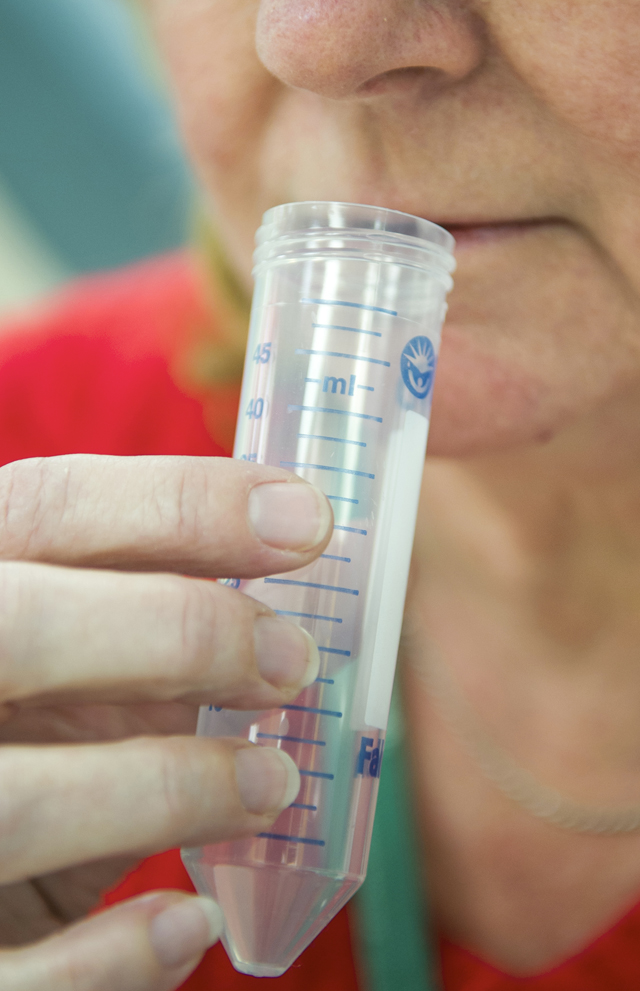There’s something in the saliva

Spitting into a test tube may save lives — and help patients avoid the stress of inaccurate oral cancer test results.
As new oral cancer diagnoses rose to more than 41,000 in 2013, and demand for early detection continues to increase, research from the college’s diagnostic sciences department could introduce an oral cancer saliva test in the future while reducing the test’s risk of false positive results.
All it takes is a test tube and a bit of saliva.
 In 2009, Dr. Yi-Shing Lisa Cheng, associate professor in diagnostic sciences, received a $381,000 R21 grant from the National Institutes of Health’s National Institute of Dental and Craniofacial Research to find reliable oral cancer salivary biomarkers, which can be used as indicators of disease or other health conditions. Cheng’s work is part of global efforts to develop a saliva test as an oral cancer screening tool.
In 2009, Dr. Yi-Shing Lisa Cheng, associate professor in diagnostic sciences, received a $381,000 R21 grant from the National Institutes of Health’s National Institute of Dental and Craniofacial Research to find reliable oral cancer salivary biomarkers, which can be used as indicators of disease or other health conditions. Cheng’s work is part of global efforts to develop a saliva test as an oral cancer screening tool.
Cheng recently received a $50,000 faculty bridge grant from Texas A&M University Health Science Center and A&M Baylor College of Dentistry’s diagnostic sciences department to continue this research. The goal: To determine whether patients with oral lichen planus and gum disease exhibit false positives for the future oral cancer saliva tests.
“Early detection of any form of cancer is always good,” says Cheng. “Using a saliva test for detecting oral cancer is a noninvasive and relatively easy procedure.
“However, to reach these goals, we have to make sure that any biomarkers we use as indicators for the presence of cancer are really reliable, which means that they must not indicate that cancer is present when it is not, because a high rate of false positives would lead to unnecessary stress for patients and a waste of medical resources.”
Cheng’s research differs from models that compare salivary biomarkers of oral cancer patients with those of completely healthy individuals. Instead, hers is directed toward finding the biomarkers of patients with noncancerous oral conditions and ruling those out from any saliva tests that may be developed in the future — one test tube at a time. It’s an effort that could save patients thousands of dollars, not to mention the mental strife and health complications associated with false positive results.
Cheng and her team — including Research Assistant Lee Jordan, Drs. Terry Rees, Emet Schneiderman and David Kang at TAMBCD, Dr. Lance Oxford at Baylor University Medical Center and Dr. Huey-Shys Chen at the University of Toledo in Ohio — have identified some promising candidate salivary biomarkers, but more testing is needed to validate initial results.
Saliva samples are being collected from the following groups:
- patients with oral cancer;
- patients with gum disease who are smokers;
- patients with gum disease who are nonsmokers;
- patients with oral lichen planus, disease active;
- patients with oral lichen planus, disease inactive; and
- healthy, non-smoking patients who have none of the above-listed diseases.